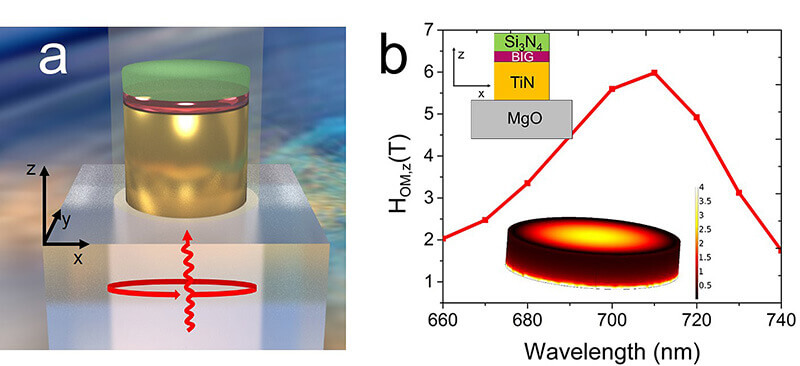July 10, 2019
Light may increase magnetic memory speeds 1,000 times, decrease electricity consumption
 Purdue University researchers have come up with technology to increase magnetic memory speeds and decrease electricity consumption. (Stock photo)
Download image
Purdue University researchers have come up with technology to increase magnetic memory speeds and decrease electricity consumption. (Stock photo)
Download image
WEST LAFAYETTE, Ind. – Internet searches, decade-old emails and on-demand video offerings help contribute to electricity consumption by America’s server farms and data centers amounting to more than 2 percent of the country’s annual total.
Those data centers – which operate millions of drives and hold massive amounts of digital data – use some 70 billion kilowatt hours per year of energy. One kWh is enough power to keep a smartphone charged for about a year. At an average cost of 10 cents per kWh, the annual cost of all that power is around $7 billion.
Now a method that can potentially reduce energy consumption in magnetic memory devices and improve their speeds is advancing at Purdue University. The method involves a combination of spintronic and photonic materials, where ultrashort laser pulses are employed to generate intense magnetic fields to manipulate the spin orientation of magnetic materials.
“We have brought together these two fields to derive a solution to a decades-old problem,” said Ernesto Marinero, a professor of materials engineering and electrical and computer engineering in Purdue’s College of Engineering. “We wanted to figure out faster ways of switching the magnetization in spintronic nanoscale memory devices.”
 This is a schematic of the proposed Purdue design to potentially reduce energy consumption in magnetic memory devices and improve their speeds. (Image provided)
Download image
This is a schematic of the proposed Purdue design to potentially reduce energy consumption in magnetic memory devices and improve their speeds. (Image provided)
Download image
Marinero worked with Vlad Shalaev and Alexandra Boltasseva, photonics experts and professors in Purdue’s College of Engineering, to develop a new magneto-photonics effort to employ light to control magnetization processes for a variety of applications – resulting in ultra-fast switchable devices.
“We are among the first to successfully develop a method for all-optical switching of on-chip nanomagnets in high-density memory modules,” Marinero said.
This emerging technology involves collective electron waves, or plasmons, triggered when light strikes a nanoscale material such as a metal that can sustain the electron waves. These plasmons generate intense, ultra-short magnetic fields at the interface of judiciously chosen optical and magnetic materials.
By changing the properties of the incident light, the direction of the resulting magnetic field is reversed, which enables the manipulation of the magnetic orientation in the magnetic material, a critical requirement for magnetic information storage. Numerical simulations conducted by Aveek Dutta, a graduate student in engineering, predict large magnetic field enhancements driven by induced plasmon excitations.
The Purdue team’s method involves using the power of optics, through features called localized surface plasmon resonances, to couple light to nanomagnets and produce faster spintronic devices switching speeds and potential lower energy consumption. The light enables switching of the magnetization orientation, the key principle behind encoding information digitally in magnetic storage devices.
“We believe that our method could ultimately lead to memory writing speeds that are 1,000 times faster than current ones,” Marinero said. “One of our key areas for success is continuing to develop materials that interact with the magnets in an efficient way.”
The researchers are working with the Purdue Research Foundation Office of Technology Commercialization to patent the technology. They are looking for additional partners and those interested in licensing the technology.
About Purdue Research Foundation Office of Technology Commercialization
The Purdue Research Foundation Office of Technology Commercialization operates one of the most comprehensive technology transfer programs among leading research universities in the U.S. Services provided by this office support the economic development initiatives of Purdue University and benefit the university's academic activities through commercializing, licensing and protecting Purdue intellectual property. The office is managed by the Purdue Research Foundation, which received the 2016 Innovation and Economic Prosperity Universities Award for Innovation from the Association of Public and Land-grant Universities. For more information on licensing a Purdue innovation, contact the Office of Technology Commercialization at otcip@prf.org. For more information about funding and investment opportunities in startups based on a Purdue innovation, contact the Purdue Foundry at foundry@prf.org.The Purdue Research Foundation is a private, nonprofit foundation created to advance the mission of Purdue University.
Writer: Chris Adam, 765-588-3341, cladam@prf.org
Source: Ernesto Marinero, eemarinero@purdue.edu

